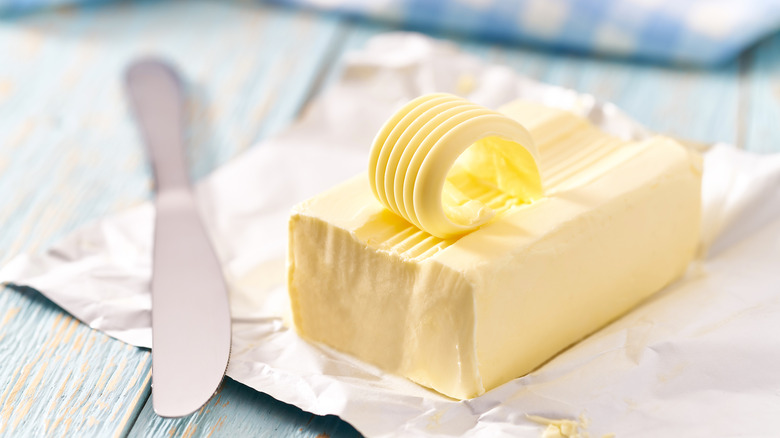Why Bacteria Plays A Role In What Separates Cultured Butter From Regular Butter
Butter is one of the building blocks of cooking, and for excellent reason. Whether you're making a sweet or savory dish, butter improves pretty much everything (although you'll want to make sure you're using the right kind for the right dish, vis a vis salted or unsalted). You can even make brown butter for an added layer of flavor. And Southern cuisine is pretty much based entirely around the concept of "put more butter in there."
Moreover, the type and brand of butter you use in a dish can make a tremendous difference. As anyone who's ever spent years making cookies with Land O'Lakes only to switch to Kerrygold on a whim can tell you that paying for the pricey stuff can have a huge effect on the end product. The reason has to do with the specifics of food science, and in particular, a butter-making process known as culturing.
Bacteria is what makes cultured butter so delicious
Cultured butter is simply butter made with cream that's been allowed to ferment first. Butter was traditionally made by pouring milk into a container and allowing it to sit for several days. The cream would separate naturally, floating to the top on account of its higher fat content. The cream was then skimmed off and churned to turn it into butter. This is how we made butter for thousands of years before refrigeration allowed us to do it quicker.
But the time involved in the traditional butter-making process also had another effect. It allowed bacteria to get involved. Instead of rendering the butter inedible, though, the bacteria in question turned the lactose in the cream into lactic acid, changing the flavor in subtle ways that we would now describe as "buttery." (The modern process deliberately adds these flavors later on to make the butter to taste like ... well, butter).
Today, pretty much all butter in Europe is still cultured. In fact, many European butter makers add bacterial cultures during the process and allow controlled fermentation to do its thing.
Uncultured butter is relatively new
Butter has been around for a really long time — it likely dates back to 8000 B.C. and was quite possibly created by accident. Supposedly, a nomadic sheep herder in Africa was traveling on a pack animal with his flock. At some point, he took a drink of sheep's milk from his sheepskin, only to find it had coagulated into a wonky mix of what would turn out to be butter and buttermilk. Like a lot of great culinary inventions, the shepherd must've said something like "Well, this is weird, but I'm really into it. Let's put it on some toast."
Up until fairly recently in human history, all butter was cultured butter. It had to be; prior to the advent of refrigeration, as well as methods to separate cream, there weren't any other options. Now, uncultured butter is both cheaper and easier to make, so of course it's the variety you see most often in America.
Still, cultures can make a huge difference; there's a reason chefs like Jet Tila swear by using cultured butter. If you're ever looking to punch up your cooking, one of the best ways to do so is to invoke that delicious cultured butter.


